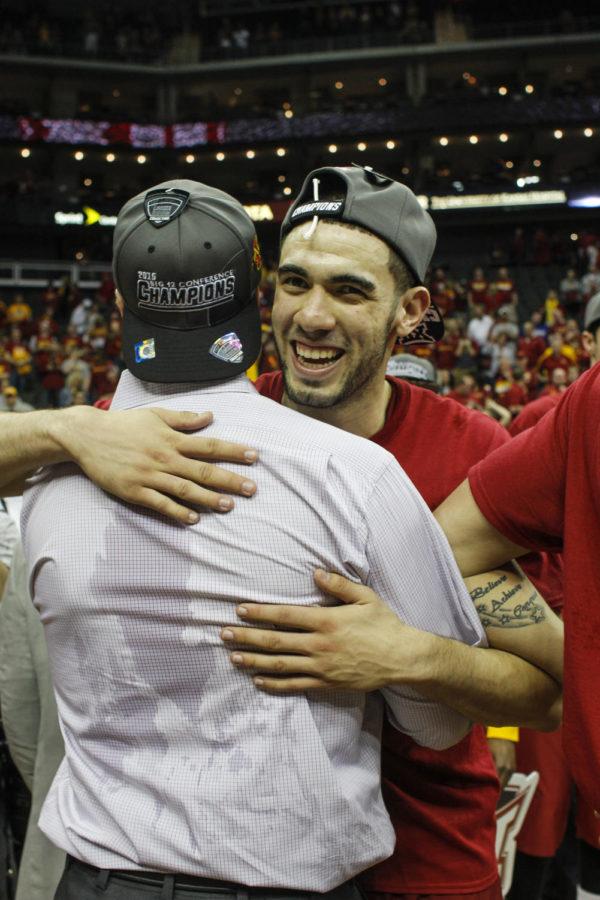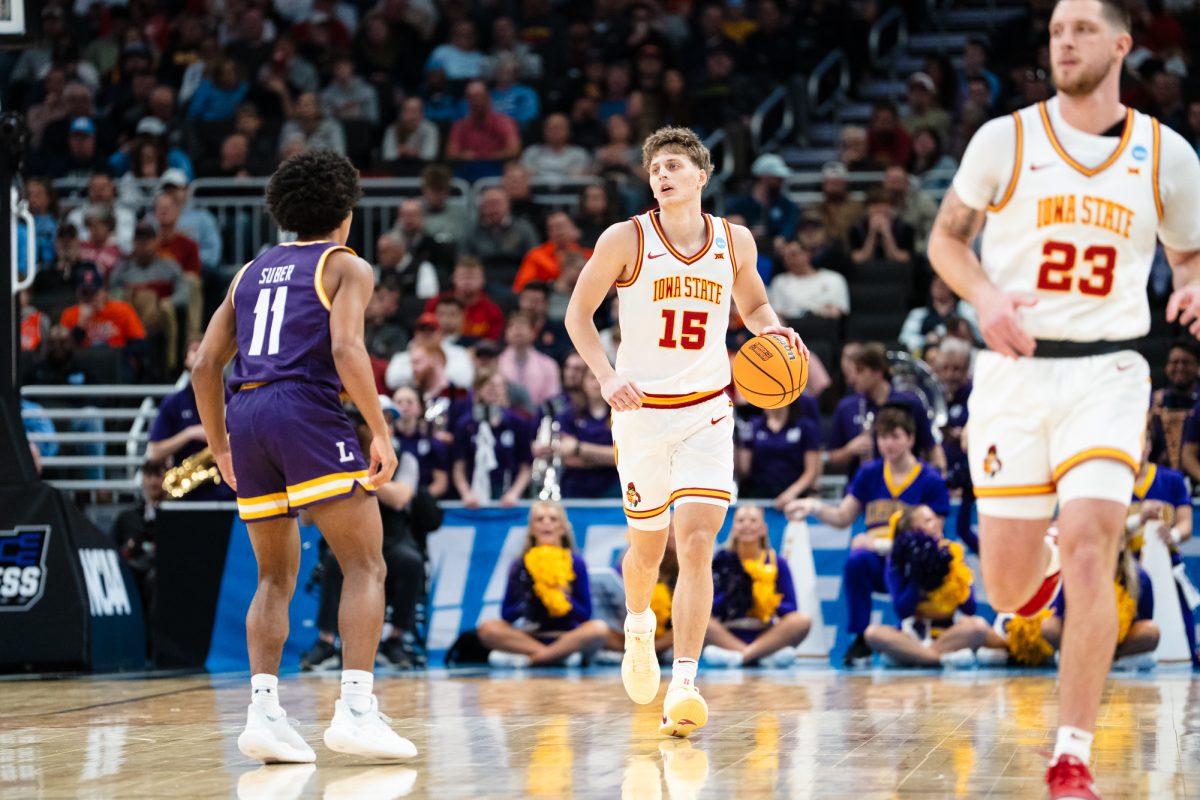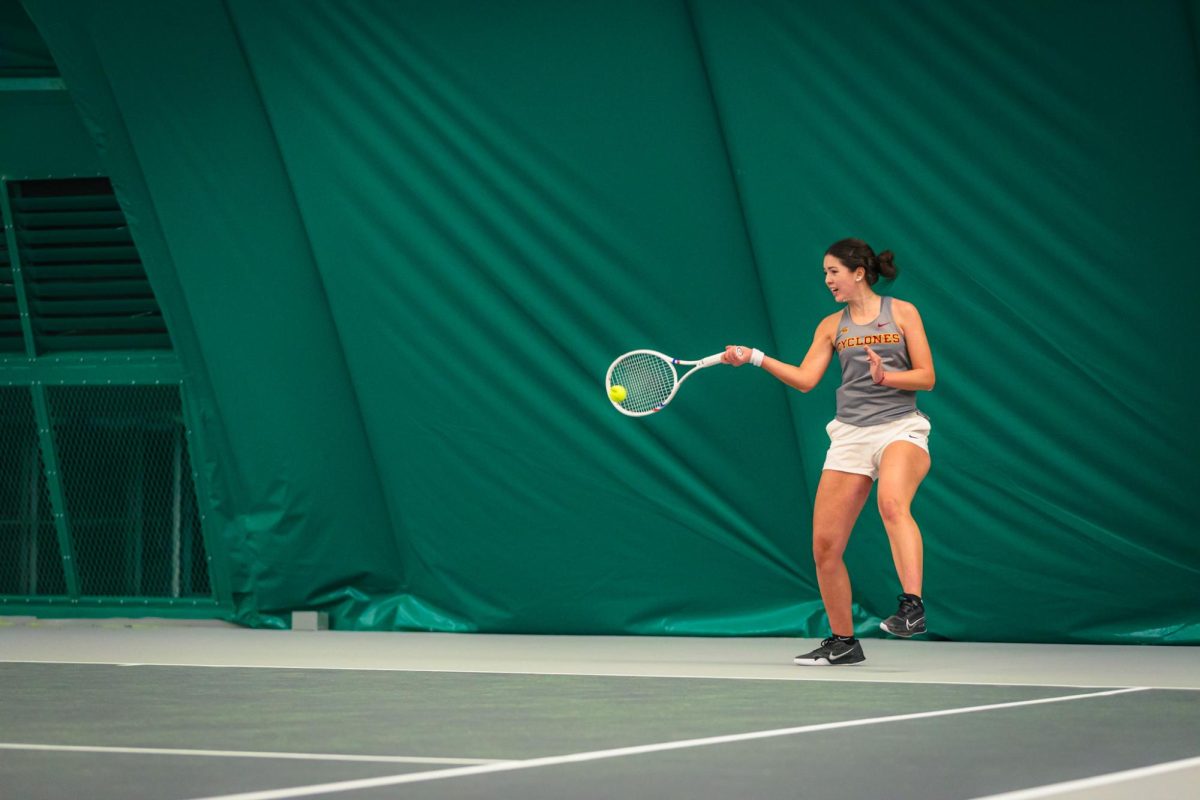The mechanics of a Big 12 title ‘run’
Junior Georges Niang hugs coach Fred Hoiberg after Iowa State defeated Kansas 70-66 in the 2015 Big 12 Championship final on March 14 at the Sprint Center in Kansas City, Mo.
March 14, 2015
Kansas City, Mo.—Multicolored streamers cascade from some hidden cache at the greatest heights of the Sprint Center.
The KU fans have departed, dejected and in disbelief. They’re not alone. This has happened to four other teams in the previous two weeks. It happened twice to Oklahoma. But the ISU faithful remain, and even though this is Kansas City and the KU campus is less than 40 minutes away, more than half the stadium is full.
Tonight, this is Cyclone territory.
Georges Niang walks off the court after leading his team to a 70-66 victory against Kansas. He hoists the Big 12 tournament trophy above his head, which is adorned by a Big 12 championship hat for the second year in a row. ISU coach Fred Hoiberg follows close behind, before getting doused in the obligatory water cooler celebration to a chorus of fan applause and approval.
These are moments that appeared nearly impossible only 19 minutes and 34 seconds before. So how did No. 13 Iowa State pull it off? How did the Cyclones come back from a double-digit deficit for the fifth game in a row? How did they eclipse a top-10 KU team that held a 17-point advantage into the second half, breaking a Big 12 title game record? How?
They did it four minutes at a time.
“I always tell the team when we’re down … to play a game within the game. Let’s win these four minutes,” said Jameel McKay, who refused a championship ring from last year’s team because he wanted to win one of his own. “When you start making that run, it’s like, you’ve got hope.”
The mechanics of a run like the one Iowa State made on March 14 are not easy to capture. For most of the ISU players, it’s difficult even to describe the experience. The crowd foaming at the mouth, the fear and disbelief in the opponents’ eyes, the fury of the opposing coach, the intensity of their teammates — it all combines to create a high that is easy to get lost in.
The Big 12 tournament’s Most Outstanding Player, Georges Niang, admitted that sometimes players don’t even realize how much ground they’ve made up — existing only in a haze of adrenaline and purpose, blind to the ancillary until the disruption of an extended play stoppage.
“When you’re coming back, I feel like you definitely keep track, but sometimes you’re so caught up in the moment, you don’t even notice,” Niang said.
One thing McKay said he did notice was that the ISU defense tends to serve its offense during epic runs. Iowa State shot 51.6 percent in the second half against Kansas, despite making only one of five 3-point attempts.
The Cyclones dominated points in the paint, outscoring the Jayhawks 46-22 in the category by strong-arming their way into the lane. Yet, it was the defense that spurred the 47-26 run Iowa State used to hoist itself to a second consecutive Big 12 tournament title.
Iowa State held Kansas to 26.3 percent shooting from the field in the latter half, allowing only 19 attempts. The Jayhawks stood at the stripe 19 times, but their increased trips to the line were symptomatic of an ISU aggression that helped create eight second half turnovers.
“[A run] just happens in a flash, honestly,” McKay said. “It’s just like … a 3 that normally we would miss, it just seems to go in and its just the confidence. Confidence comes with that defense. When we defend and get stops, we tend to score a lot easier.”
Hoiberg factors in as well, but as a manager, one of his primary jobs amidst second half runs like those the Cyclones have made against Oklahoma, Texas and Kansas is simply to stay out of the way. He considers carefully which lineup adjustments to make and keeps intensity up once the lion’s share of the gap has been closed.
Because until the final buzzer sounds, nothing has actually been achieved but a more aesthetically pleasing scoreboard.
“The one thing when you finally pull even, you can’t get satisfied,” Hoiberg said. “You [have to] keep your foot on the gas and try to continue to go out there and do the things that [helped you] get back into the game. And I thought our guys did that. They continued to attack.”
Why Iowa State has been incapable of attacking to begin games in the same fashion they have been attacking to finish them yet remains a mystery to the ISU brass.
Hoiberg, McKay and Niang all admitted that throughout the course of this season, it’s impossible to find an example of 40 straight minutes of that level of basketball. But that doesn’t mean they’re going to stop trying.
McKay said right now, his team is winning games in spurts, but sooner or later a complete game is going to happen. Niang echoed McKay’s comments, posing a question on the minds of basketball fans across the country — a question quite relevant to every single team about to be selected to the NCAA tournament field of 68.
“I wonder what would happen if we could put 40 minutes together?”







